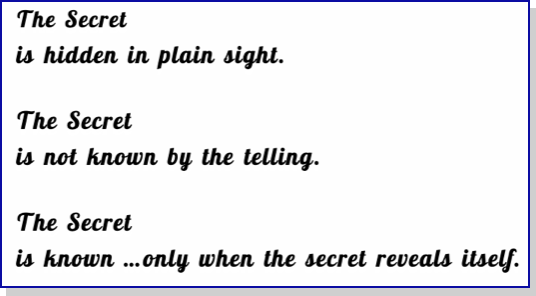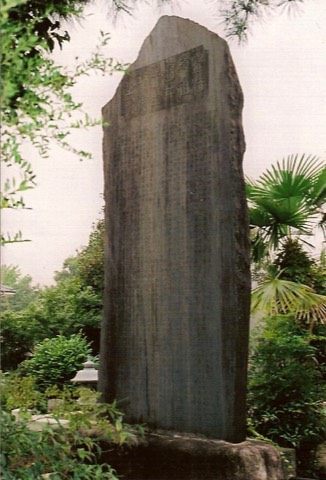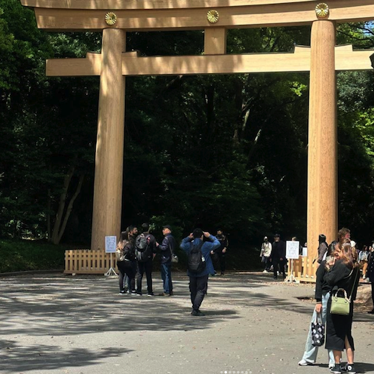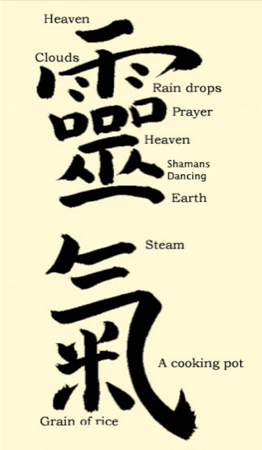The Way of Self Discovery
General Principles
What follows is the short version of the path I followed, how this worked for me. It doesn’t have to be your path. Use what works for you. Share your experience with others. I don't own the process. I am still exploring where the experience is taking me.
My first step was to acknowledge that the only thing I truly know is my own direct experience, where my own practice had taken me. What was received from, and taught by others was their truth and not 'the truth'.
I learned to live with a degree of uncertainty, to acknowledge and be comfortable with what was not known. From the space of not knowing, I trusted my inner guidance, the voice of stillness, to be shown a direction to take. My practice became one of being open to and allowing, of what I was seeking to reveal itself in my practice.
Asking the question 'What is really happening here?' became second nature. Answers came. I continued to ask the question, observing the answers as they changed and evolved, noting when the answer stopped changing.
I became more conscious of 'language spells', words that create limits. I avoided the language of 'doing Reiki', 'sending Reiki' and 'Reiki works …" and "Reiki does…'. In this manner questions about the nature of the system and the practice became more clear and the threads of what I call tsm emerged.
My first step was to acknowledge that the only thing I truly know is my own direct experience, where my own practice had taken me. What was received from, and taught by others was their truth and not 'the truth'.
I learned to live with a degree of uncertainty, to acknowledge and be comfortable with what was not known. From the space of not knowing, I trusted my inner guidance, the voice of stillness, to be shown a direction to take. My practice became one of being open to and allowing, of what I was seeking to reveal itself in my practice.
Asking the question 'What is really happening here?' became second nature. Answers came. I continued to ask the question, observing the answers as they changed and evolved, noting when the answer stopped changing.
I became more conscious of 'language spells', words that create limits. I avoided the language of 'doing Reiki', 'sending Reiki' and 'Reiki works …" and "Reiki does…'. In this manner questions about the nature of the system and the practice became more clear and the threads of what I call tsm emerged.

The Order of Secrets
'The Secret Method to Invite Happiness'
Reiki is a force ...beyond the comprehension of man. Yet, every single living being is receiving its blessings daily, awake or asleep.
Hawayo Takata

Thus, before teaching, the'‘Ikun' (admonition) of the Meiji Emperor should reverently be read and Five Precepts be chanted and kept in mind mornings and evenings.
Firstly it reads, Today do not anger,
secondly it reads, Do not worry,
thirdly it reads, Be thankful,
fourthly it reads, Work with diligence,
fifthly it reads, Be kind to others.
Firstly it reads, Today do not anger,
secondly it reads, Do not worry,
thirdly it reads, Be thankful,
fourthly it reads, Work with diligence,
fifthly it reads, Be kind to others.
Precepts: Usui Memorial Stone
Translation
First Degree Practice
My initial class experience made me question the therapy or modality focus even if useful in many ways as such. I did as my professional training had taught me, went with the flow, keep looking for the reality. What I was seeking eventually found me, the trail of 'The NOW'.
The first NOW thread was there in plain sight, in the Reiki precepts: each one an instruction for being 'in the now moment’, an every moment point of mindfulness. That first NOW thread then connected to the NOW thread in the hands-on treatments, when the energy healing connotations were put aside.
I made the identification of hands-on treatments as 'instant meditation' in my first experience of treatment when taking first degree. Treatment practice eventually became a practice of meditative stillness and presence, of being present with oneself and to the presence that is the receiver of the treatment.
Years of public treatment practice solidified this perception. What I was not expecting was the development of an awareness of embodied presence, a presence that could be with me anywhere and everywhere.
Presence, Resonance, Entrainment, these aspects of stages of a treatment emerged repeatedly in my treatment practice. Embodied presence is key: nothing to do, nowhere to go. In short, a simple practice, nothing complicated, hands on, be present, eyes open, attention on the hands as a place to return awareness if the mind drifts. Essentially the simple first degree practice as Hawayo Takata described it.
This is my practice, what I do, how I do it. No intention is made other than to be present, letting go of outcome, what happens is what happens. The outcome is totally the choice of the recipient at levels I do not need to know.
I have self treated daily since first degree. I have every day an hour long treatment with my partner, one day myself on the table, and her the next. This routine has served as the foundation of the awarenesses out of which Reikitsm has emerged.
The first NOW thread was there in plain sight, in the Reiki precepts: each one an instruction for being 'in the now moment’, an every moment point of mindfulness. That first NOW thread then connected to the NOW thread in the hands-on treatments, when the energy healing connotations were put aside.
I made the identification of hands-on treatments as 'instant meditation' in my first experience of treatment when taking first degree. Treatment practice eventually became a practice of meditative stillness and presence, of being present with oneself and to the presence that is the receiver of the treatment.
Years of public treatment practice solidified this perception. What I was not expecting was the development of an awareness of embodied presence, a presence that could be with me anywhere and everywhere.
Presence, Resonance, Entrainment, these aspects of stages of a treatment emerged repeatedly in my treatment practice. Embodied presence is key: nothing to do, nowhere to go. In short, a simple practice, nothing complicated, hands on, be present, eyes open, attention on the hands as a place to return awareness if the mind drifts. Essentially the simple first degree practice as Hawayo Takata described it.
This is my practice, what I do, how I do it. No intention is made other than to be present, letting go of outcome, what happens is what happens. The outcome is totally the choice of the recipient at levels I do not need to know.
I have self treated daily since first degree. I have every day an hour long treatment with my partner, one day myself on the table, and her the next. This routine has served as the foundation of the awarenesses out of which Reikitsm has emerged.
The relationship with the symbols becomes not with the symbol itself, but with the nature of that which the symbol represents.
Mark Ruge
Second Degree and Beyond
In the second degree practice, the idea is sometimes expressed that the symbols are simply tools or training wheels that can be discarded when they are no longer necessary. This thought arises at a point in the practice where the use of the symbol has become automatic, or second nature. The next developmental stage of symbol use is with THAT which the symbol actually represents. This aspect is largely an unknown and unrecognised.
Recognising this 'automatic mode' had occurred in my own practice, curiosity led me to a mindful reengagement, recreating a relationship that had become habitual. I began my practice anew, as a beginner who knows nothing but a name and a pattern. Everything I thought I knew was set aside.
I began to draw the symbol mindfully with my hand, observed the pattern, watched as the symbol seemed to draw itself with my hand following. I affirmed my lack of knowing and asked to be shown what I needed to know. This process took some time and focus, and almost magically the symbols began to reveal their nature and the 'secrets' they held as I did the practice.
Hawayo Takata used the words 'secret and sacred’ in relation to the symbols. My experience now, is that the symbols absolutely do carry secrets, and the nature of what they have to reveal is in the realm of what may be consider 'sacred', something one holds close to one’s heart. This relationship process continues to deepen with time.
By way of this mindful practice the thread of the NOW emerged again. The symbol practice is initially a minded relationship with the symbol itself, and at a later development stage connecting with the nature of THAT which the symbol actually represents. This is a multi layered experience and knowing. Treating the symbols as tools or training wheels is 'fatal’ in this process.
Recognising this 'automatic mode' had occurred in my own practice, curiosity led me to a mindful reengagement, recreating a relationship that had become habitual. I began my practice anew, as a beginner who knows nothing but a name and a pattern. Everything I thought I knew was set aside.
I began to draw the symbol mindfully with my hand, observed the pattern, watched as the symbol seemed to draw itself with my hand following. I affirmed my lack of knowing and asked to be shown what I needed to know. This process took some time and focus, and almost magically the symbols began to reveal their nature and the 'secrets' they held as I did the practice.
Hawayo Takata used the words 'secret and sacred’ in relation to the symbols. My experience now, is that the symbols absolutely do carry secrets, and the nature of what they have to reveal is in the realm of what may be consider 'sacred', something one holds close to one’s heart. This relationship process continues to deepen with time.
By way of this mindful practice the thread of the NOW emerged again. The symbol practice is initially a minded relationship with the symbol itself, and at a later development stage connecting with the nature of THAT which the symbol actually represents. This is a multi layered experience and knowing. Treating the symbols as tools or training wheels is 'fatal’ in this process.

Tori Gate
Passing through the torii gate,
one enters the space of the sacred.

Reiki Kanji
To perceive the way of 'seeing' beyond the symbol itself to that which it is representing, consider the calligraphy of the Reiki kanji. The kanji presents as a combination of brush strokes and a name. Rei-ki. A simple 'universal energy' translation is taken as a foundation for beliefs about the practice. But, we don't KNOW it beyond this basic information that someone told us was so. Many never delve deeper. If we do, we will discover that the kanji is a picture symbol, each brush stroke carries a meaning, clouds, rain, shamans dancing etc.
Putting these concepts together, the meaning of the strokes create a context. An image builds carrying a more nuanced meaning. Then perhaps, we project ourselves into the image, see the shamans dancing in the rain, mouths open, feeling the rain on their skin, in joy and gratitude for this gift of life from heaven. We may even allow ourselves to feel the feeling ourselves, and a whole new level of understanding that this image carries is revealed.
So it is with the symbols. The shape, the words that accompany the symbol, are all pointers to the nature of an experience. Allow the symbols to present an image that the lines suggest, picture it in detail. Project yourself into that image, and feel the feeling of it. When you know, you will know. There are no shortcuts that I have found.
All that is then left to do is 'Practice. Practice. Practice', and 'Let Reiki teach you!'.
Putting these concepts together, the meaning of the strokes create a context. An image builds carrying a more nuanced meaning. Then perhaps, we project ourselves into the image, see the shamans dancing in the rain, mouths open, feeling the rain on their skin, in joy and gratitude for this gift of life from heaven. We may even allow ourselves to feel the feeling ourselves, and a whole new level of understanding that this image carries is revealed.
So it is with the symbols. The shape, the words that accompany the symbol, are all pointers to the nature of an experience. Allow the symbols to present an image that the lines suggest, picture it in detail. Project yourself into that image, and feel the feeling of it. When you know, you will know. There are no shortcuts that I have found.
All that is then left to do is 'Practice. Practice. Practice', and 'Let Reiki teach you!'.
Change Date - 27/11/2023